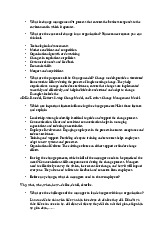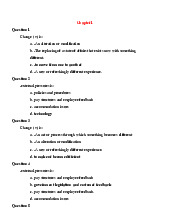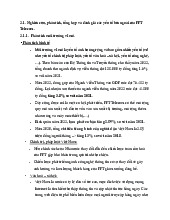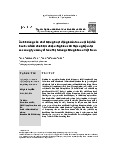

Preview text:
lOMoAR cPSD| 47206071 REVIEW FOR FINAL EXAM
A. THE CHALLENGE OF CHANGE
1. The process of change, types of changes
2. What are the challenges of change?
• People: “the most important resource of this business is its people”.
• The most challenges of change are people side & uncertainty future
• Change architecture: set of arrangements, systems, resources and processes through which
we engage people in “productive reasoning” focused on creating a new future.
THE TRANSFORMATION PERSPECTIVE
1. Define transformation perspective: The mind-set of….
2. The needs for transformation….
3. Contents should be covered in the transformation initiatives.
4. Organizational transformation is the strategic method of…
B. THE CONDITIONS FOR CHANGE
1. 3 types of change situations
2. External environments for change
• The purposes of PESTLE Analysis
• How to Monitor competition: Evolutionary cycle of competitive behavior
3. Internal environments for change
• Purposes of Internal analysis
• Identifying Key Success Factors (KSF): Definition
• Resources Audit: What to audit?
C. THEORIES OF ORGANIZATION CHANGE
1. What is resistance to change? How to overcome it?
2. Traditional models (mention to the focus of each approach)
• Linear approaches o (a series of steps, Lewin’s Model (understand nature of each stage and
can know how to develop activity for a change program using the model), o 8 stages of Kotters
D. CHANGE MANAGEMENT TECHNIQUES AND STRATEGIC CHANGE 1. Diagnosing change
• Efficiency and effectiveness (when organization to be effective)
• Understanding the “human” dimension of change (characteristic of each types and their implications)
- “Rational–economic man” , “Social man”
- “Self-actualizing man”, ‘Complex man” Page 1 of 2
2. Managing Major Change :
• Managerial skills for effective organizational change
- Managing transitions (five criteria for effective transition management)
- Dealing with organizational cultures (Organizational issues faced if more
adaptable organizational culture are to be achieved)
- Managing politics in organization change • Coping with change - The coping cycle
Why do managers need to understand the coping cycle?
3. Change Architecture • Cycles of change
• Learning and change • Program of Change
4. Strategy for organizational effectiveness
• Force field analysis
5. Cultural Models and Organizational Change
• Models of organizational culture. Can we easily change an organizational culture?
• Managing corporate politics (political skills include)
• Should we eliminate conflicts & politics in organizations?
E. THEMES AND ISSUES IN ORGANIZATION CHANGE
1. Leadership in practice
• Leaders and situations: (situational leadership theory from Paul Hersey & Blanchard et al,)
2. The learning organization :
− What is a learning organization?
− Disciplines for the learning organization THE END Page 2 of 2



